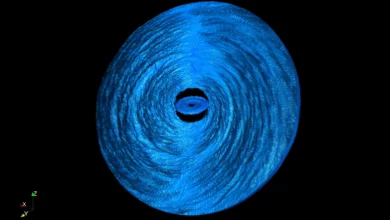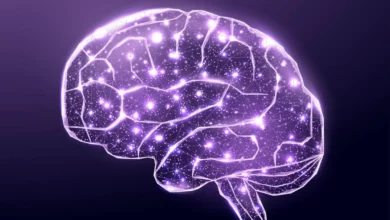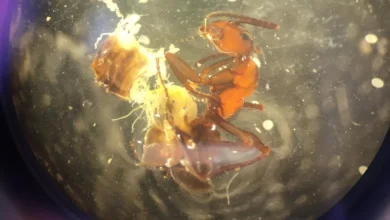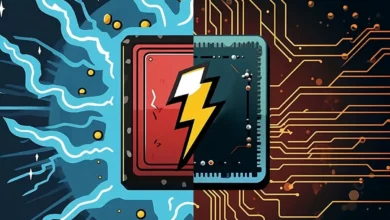Latest Articles
-
Sep- 2023 -22 SeptemberAstronomy

Gobbling Galaxies: Black Holes’ Speedy Feast Shocks Scientists
Lead Image: A new study shows that, by dragging space-time, supermassive black holes can rip apart the violent whirlpool of debris (or accretion disks) that encircle them, resulting in an inner and outer subdisk. Credit: Nick Kaaz/Northwestern University New research reveals that supermassive black holes consume surrounding material faster than previously believed. This insight, derived from high-resolution simulations, could explain why quasars flare and fade so quickly. A new Northwestern University-led study is changing the way astrophysicists understand the eating habits of supermassive black holes. While previous researchers have hypothesized that black holes eat slowly, new simulations indicate that black…
Read More » -
19 SeptemberNano Particles

Preventing $220 Billion in Damages – Scientists Discover Potential Way To Disarm a Mysterious Family of Microbial Proteins
Researchers have identified how certain harmful bacterial proteins, AvrE/DspE, cause diseases in crops by suppressing plants’ immune systems. Using AI predictions, the team found that these proteins create channels in plants, leading to infections, but also discovered nanoparticles that can block these channels, effectively preventing the bacteria from causing harm, which could save the global economy $220 billion lost to plant diseases annually. Researchers from Duke University might have discovered a method to neutralize them, potentially averting $220 billion in yearly agricultural losses. Many of the bacteria that ravage crops and threaten our food supply employ a shared tactic to…
Read More » -
18 SeptemberMental Health

Scientists Discover “Startling” Levels of Hidden Mental Health Symptoms Among Autoimmune Disease Patients
Lead Image: Over half of patients with autoimmune conditions suffer from mental health issues like depression or anxiety, yet many are not routinely asked about these symptoms in clinical settings, reveals a study by the University of Cambridge and King’s College London. The research indicates that the prevalence and range of these mental health symptoms are more extensive than previously known, and there’s a significant disparity between patient experiences and clinician perceptions. Experts urge immediate mental health assistance for patients with autoimmune diseases. Over 50% of patients with autoimmune disorders suffer from mental health issues like depression or anxiety. However,…
Read More » -
17 SeptemberBiodiversity

Mechanisms of Mind Control: Brain-Altering Parasite Turns Ants Into Zombies at Dawn and Dusk
Lead Image: Dissected ant and where you can see the encapsulated parasites (white oval structures) spilling out of the hind body. Credit: Brian Lund Fredensborg It takes over the brains of ants, causing them to cling to blades of grass against their will. The lancet liver fluke has an exceptional lifecycle strategy, in which snails, ants, and grazing animals are unwitting actors. Researchers are now investigating the precise mechanisms behind this intriguing form of mind control. Imagine coming to, jaws gripping the top of a swaying blade of grass, unaware of how you got there. That’s the reality for ants…
Read More » -
15 SeptemberMoore's Law

Beyond Moore’s Law: MIT’s Innovative “Lightning” System Combines Light and Electrons for Faster Computing
MIT researchers introduce Lightning, a reconfigurable photonic-electronic smartNIC that serves real-time deep neural network inference requests at 100 Gbps. Credit: Alex Shipps/MIT CSAIL via Midjourney “Lightning” system connects photons to the electronic components of computers using a novel abstraction, creating the first photonic computing prototype to serve real-time machine-learning inference requests. Computing is at an inflection point. Moore’s Law, which predicts that the number of transistors on an electronic chip will double each year, is slowing down due to the physical limits of fitting more transistors on affordable microchips. These increases in computer power are slowing down as the demand…
Read More »










